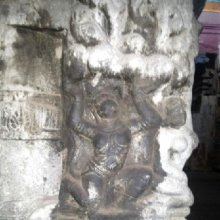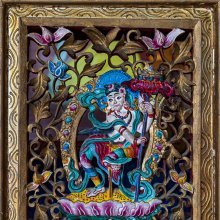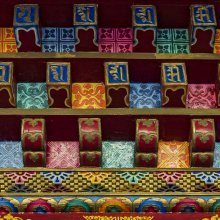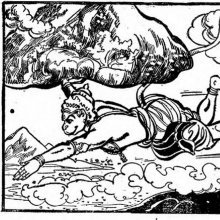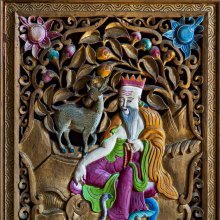Mountain: 3 definitions
Introduction:
Mountain means something in Hinduism, Sanskrit. If you want to know the exact meaning, history, etymology or English translation of this term then check out the descriptions on this page. Add your comment or reference to a book if you want to contribute to this summary article.
Images (photo gallery)
(+46 more images available)
In Hinduism
Shaktism (Shakta philosophy)
Source: Google Books: ManthanabhairavatantramMountains, it seems, were amongst the earliest sacred places. The worship of sacred mountains is a feature of Epic and Purāṇic religion no less than Tantric. Amongst them the Kula mountains are considered to be the most sacred. According to the Epics and the Purāṇas they are seven. Considered to be the centre of the world by Buddhists, Jains and Hindus alike, Kailāśa is by far the best known of all the sacred mountains in Asia. As it is Śiva’s abode, it is understandably an important place in the sacred geography of the Kubjikā Tantras where it is identified with the triangular mount Meru. Said to be another form of Kailāśa, it is, as we have seen, one of many representations of the triangular Yoni located in the End of the Twelve above the head. The teachings are transmitted from here and so are said to come down along the Path of Meru. The Kularatnoddyota couples this mountain, which is located in Tibet behind the Himalayas, with mount Malaya in South India.
These mountains, which are the world and the body of the goddess, originate, according to the Kularatnoddyota, from the first two mountains—Kailāśa and Malaya—which represent the most fundamental of polarities. In their original transcendent oneness they constitute the Kramamaṇḍala of the goddess. Kailāśa stands for ‘Krama’, that is, the series of mantras that constitute the transmission, and Malaya for the ‘maṇḍala’ into which they are projected.

Shakta (शाक्त, śākta) or Shaktism (śāktism) represents a tradition of Hinduism where the Goddess (Devi) is revered and worshipped. Shakta literature includes a range of scriptures, including various Agamas and Tantras, although its roots may be traced back to the Vedas.
Vastushastra (architecture)
Source: Shodhganga: Elements of Art and Architecture in the Trtiyakhanda of the Visnudharmottarapurana (vastu)Mountains should surround the construction site of Temples, according to Puranic lore such as the Bhaviṣyapurāṇa and Viṣṇudharmottarapurāṇa, an ancient Sanskrit text which (being encyclopedic in nature) deals with a variety of cultural topics such as arts, architecture, music, grammar and astronomy.—Selection of proper site is very necessary for any construction. It is the prime and first duty of the constructor or the proprietor to find out a perfect land which should possess the required qualities. [...] In the Bhaviṣyapurāṇa it is stated that, the abode of God should be established near the forest and the place should be full of rivers, mountains and springs.

Vastushastra (वास्तुशास्त्र, vāstuśāstra) refers to the ancient Indian science (shastra) of architecture (vastu), dealing with topics such architecture, sculpture, town-building, fort building and various other constructions. Vastu also deals with the philosophy of the architectural relation with the cosmic universe.
Shilpashastra (iconography)
Source: Shodhganga: Elements of Art and Architecture in the Trtiyakhanda of the Visnudharmottarapurana (shilpa)1) The Mountain refers to class of natural objects and phenomenon which follows specific guidelines in the tradition of ancient Indian Painting (citra), according to the Viṣṇudharmottarapurāṇa, an ancient Sanskrit text which (being encyclopedic in nature) deals with a variety of cultural topics such as arts, architecture, music, grammar and astronomy.—The Viṣṇudharmottarapurāṇa bears an elaborate description on the process of making the picture of some natural objects and phenomenon, e.g., Mountains. Accordingly, the picture of mountain should be adorned with plenty of rocks, peaks, metals, trees, streams and snakes. In the Kumārasambhava of Kālidāsa, the mountain Himālaya has been described as the storehouse of metals. [...]. Thus, the Viṣṇudharmottarapurāṇa addresses various elements of nature, such as Mountains, since painting has much connection with time, mood and activity.
2) Mountains (personified) follows specific guidelines of ancient Indian Painting (citra).—In the Viṣṇudharmottarapurāṇa, the technique of personification is seen to be used in the context of Painting also. The Mountains should have hands in the form of peaks. In the Kumārasambhava, the Himālaya is personified as the lord of mountain and the father of Pārvatī. But in the Kumārasambhava, the peaks of mountain Himālaya are not described as the hands of the mountain as said in the Viṣṇudharmottarapurāṇa.

Shilpashastra (शिल्पशास्त्र, śilpaśāstra) represents the ancient Indian science (shastra) of creative arts (shilpa) such as sculpture, iconography and painting. Closely related to Vastushastra (architecture), they often share the same literature.
See also (Relevant definitions)
Starts with (+48): Mountain acanthus, Mountain agathis, Mountain alder, Mountain aloe, Mountain apple, Mountain apple tree, Mountain arnica, Mountain ash, Mountain asphodel, Mountain blue penstemon, Mountain bluebells, Mountain box, Mountain bush aloe, Mountain cave, Mountain cumin, Mountain date, Mountain deathcamas, Mountain dog-laurel, Mountain dogwood, Mountain draba.
Ends with: Fire on the mountain, Snow on the mountain, Spiny mountain.
Full-text (+7733): Kailasa, Parvata, Vindhya, Meru, Mahendra, Gandhamadana, Sumeru, Mandara, Malaya, Shaila, Mainaka, Trikuta, Mahidhara, Citrakuta, Sahya, Pariyatra, Giri, Bhudhara, Parvatiya, Shriparvata.
Relevant text
Search found 417 books and stories containing Mountain; (plurals include: Mountains). You can also click to the full overview containing English textual excerpts. Below are direct links for the most relevant articles:
The Markandeya Purana (by Frederick Eden Pargiter)
Canto LV - The Geography of Jambudvīpa
Canto LVI - The Descent of the Ganges
Chapter XII - The Nature Of Mountains
Chapter VIII - The Battle With The Earth
The Agni Purana (by N. Gangadharan)
Chapter 108 - Cosmographical account (bhuvana-koṣa)
Chapter 212 - Gifts granting the desired fruits
Historical Elements in the Matsya Purana (by Chaitali Kadia)
Saptadvīpa (1): Jambudvīpa (Introduction) < [Chapter 4 - Geographical history in the Matsya-Purāṇa]
Saptadvīpa (6): Gomedakadvīpa < [Chapter 4 - Geographical history in the Matsya-Purāṇa]
Saptadvīpa (3): Kuśadvīpa < [Chapter 4 - Geographical history in the Matsya-Purāṇa]
Harivamsha Purana (by Manmatha Nath Dutt)
Chapter 31 - The Creation of Mountains and Rivers < [Book 3 - Bhavishya Parva]
Chapter 42 - Jarasandha’s Instructions to the Kings < [Book 2 - Vishnu Parva]
Chapter 18 - Indra Sends Down Punishment < [Book 2 - Vishnu Parva]
The Shiva Purana (by J. L. Shastri)
Chapter 37 - The letter of betrothal is dispatched < [Section 2.3 - Rudra-saṃhitā (3): Pārvatī-khaṇḍa]
Chapter 42 - Description of the meeting of the lord and the mountain < [Section 2.3 - Rudra-saṃhitā (3): Pārvatī-khaṇḍa]
Chapter 17 - Description of the Jambūdvīpa (jambū-dvīpa) < [Section 5 - Umā-Saṃhitā]
Related products
(+12 more products available)
